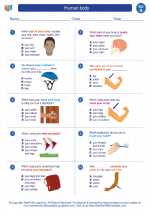Axons
An axon is a long, slender projection of a nerve cell, or neuron, that conducts electrical impulses away from the neuron's cell body or soma. Axons are essential for the transmission of information within the nervous system.
Structure of an Axon
The structure of an axon includes:
- Axon hillock: The region where the axon originates from the cell body.
- Myelin sheath: A fatty covering that insulates and protects the axon, helping to speed up the transmission of electrical impulses.
- Nodes of Ranvier: Gaps in the myelin sheath where the axon is exposed, allowing for the efficient propagation of the electrical signal.
- Axon terminals: The end of the axon where it forms synapses with other neurons or target cells.
Function of Axons
Axons transmit electrical impulses, known as action potentials, from the cell body to the axon terminals. These impulses are crucial for communication between neurons and for signaling throughout the nervous system.
Study Guide
Here are some key points to remember about axons:
- What is the function of an axon?
- Describe the structure of an axon, including the axon hillock, myelin sheath, nodes of Ranvier, and axon terminals.
- Explain how the myelin sheath and nodes of Ranvier contribute to the function of an axon.
- What is the role of axon terminals in neuronal communication?
- Discuss the importance of axons in the nervous system.
Understanding the structure and function of axons is essential for grasping the fundamentals of how the nervous system operates and how information is transmitted within the body.
[Axons] Related Worksheets and Study Guides:
.◂Science Worksheets and Study Guides First Grade. Human body
Study Guide Human body
Human body  Activity Lesson
Activity Lesson Human Body
Human Body  Worksheet/Answer key
Worksheet/Answer key Human body
Human body  Worksheet/Answer key
Worksheet/Answer key Human body
Human body  Worksheet/Answer key
Worksheet/Answer key Human body
Human body  Worksheet/Answer key
Worksheet/Answer key My Senses
My Senses  Worksheet/Answer key
Worksheet/Answer key Human Body
Human Body  Worksheet/Answer key
Worksheet/Answer key Inside the Body
Inside the Body  Vocabulary/Answer key
Vocabulary/Answer key Human body
Human body  Vocabulary/Answer key
Vocabulary/Answer key Human body
Human body 

 Activity Lesson
Activity Lesson
 Worksheet/Answer key
Worksheet/Answer key
 Worksheet/Answer key
Worksheet/Answer key
 Worksheet/Answer key
Worksheet/Answer key
 Worksheet/Answer key
Worksheet/Answer key
 Worksheet/Answer key
Worksheet/Answer key
 Worksheet/Answer key
Worksheet/Answer key
 Vocabulary/Answer key
Vocabulary/Answer key
 Vocabulary/Answer key
Vocabulary/Answer key

The resources above cover the following skills:
LIFE SCIENCE
From Molecules to Organisms: Structures and Processes
Design a solution to a human problem by using materials to imitate how plants and/or animals use their external parts to help them survive, grow, and meet their needs (e.g., outerwear imitating animal furs for insulation, gear mimicking tree bark or shells for protection).